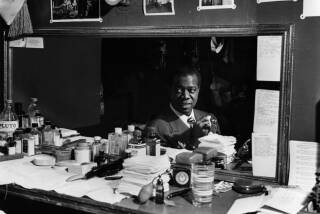Jazz Great Roy Eldridge, Innovator on Trumpet, Dies
- Share via
Roy Eldridge, one of the great innovators on the jazz trumpet, died Sunday in New York at the age of 78.
Eldridge’s passing in a hospital in Valley Stream, Long Island, came just three weeks after the death of his wife of 53 years, Viola.
“He just stopped eating and wanted to die,” said a friend of the musician.
In naming him a member of his “greatest All-Star Jazz Band” several years ago, Times jazz critic Leonard Feather wrote:
“Roy Eldridge has often been called the link between (Louis) Armstrong and Dizzy Gillespie, but he was much more. To what Armstrong had contributed he added many new elements: longer, crackling, fiery phrases, sudden upward and downward movements, growling guttural sounds and often a sense of intensity that surpassed even Armstrong’s.”
It was in the 1930s and ‘40s that the trumpeter reached the high point of his career, but at a time of great difficulty for black musicians. When he left Artie Shaw’s band in 1945, he complained bitterly about many racial incidents while on tour and declared that he could never again play with a white band, even though Shaw, personally, had been nice to him.
Later, however, he did play with many such bands as segregation faded.
Born David Roy Eldridge in Pittsburgh, Pa., on Jan. 30, 1911, Eldridge studied with his elder brother, the late Joe Eldridge, playing the drums and appearing publicly for the first time at the age of only 6. Later, he got much early experience playing the horn at carnivals.
Coming to New York City in 1930, he worked in Cecil Scott’s band and later with the Elmer Snowden Band at Smalls, then with Teddy Hill, Connie’s Hot Chocolates, Fletcher Henderson and Mal Hallett, performing often as a soloist and occasionally organizing his own bands.
Eldridge became nationally prominent as the featured trumpeter and singer with Gene Krupa’s band from 1941 to 1943, at the same time becoming one of the first black jazz musicians to be accepted as a permanent member of the brass section of a white band.
After ending his tour with Shaw, he served a long stint with Norman Granz’s Jazz at the (New York) Philharmonic.
In 1950, with some saying he had become old-fashioned, he joined the Benny Goodman sextet for a European tour and remained on the Continent for 18 months. He was a great hit in France, where he made some of his most famous recordings.
Returning to the United States in 1951, he became part of the mainstream jazz movement, frequently appearing in small groups with Benny Carter, Johnny Hodges, Ella Fitzgerald and Coleman Hawkins.
Described by music magazine editor Barry Ulanov as “a biting, driving brass man, almost without equal for sheer power from the earliest years of swing,” he was known for an exuberant personality and a keen sense of competition.
Even in his later years, he enjoyed challenging younger musicians to cutting contests, according to Groves Dictionary of Jazz.
Groves said that Eldridge drew his main inspiration not from Armstrong but from the saxophonists Carter and Hawkins, “whose fleet arpeggio style and rich tone he adapted to his instrument. As a result, Eldridge early acquired a keen awareness of harmony, an unprecedented dexterity, particularly in the highest register, and a full, slightly overblown timbre, which crackled at moments of high tension.”
He also had a formative impact on early bop musicians, and his work in swing had particular influence over Gillespie, with whom he competed in a series of “trumpet battles” at Minton’s in the early 1940s.
By the late 1950s, Eldridge was alternating between fluegelhorn and trumpet. He was an adequate performer on piano, bass and drums. As a singer, he had what is described as a “personable, gruff quality,” and his best-known song was “Let Me Off Uptown,” a duet with Anita O’Day.
Eldridge, who lived in Queens, N.Y., is survived by a daughter, Carol.
Funeral arrangements were incomplete.
More to Read
The biggest entertainment stories
Get our big stories about Hollywood, film, television, music, arts, culture and more right in your inbox as soon as they publish.
You may occasionally receive promotional content from the Los Angeles Times.









